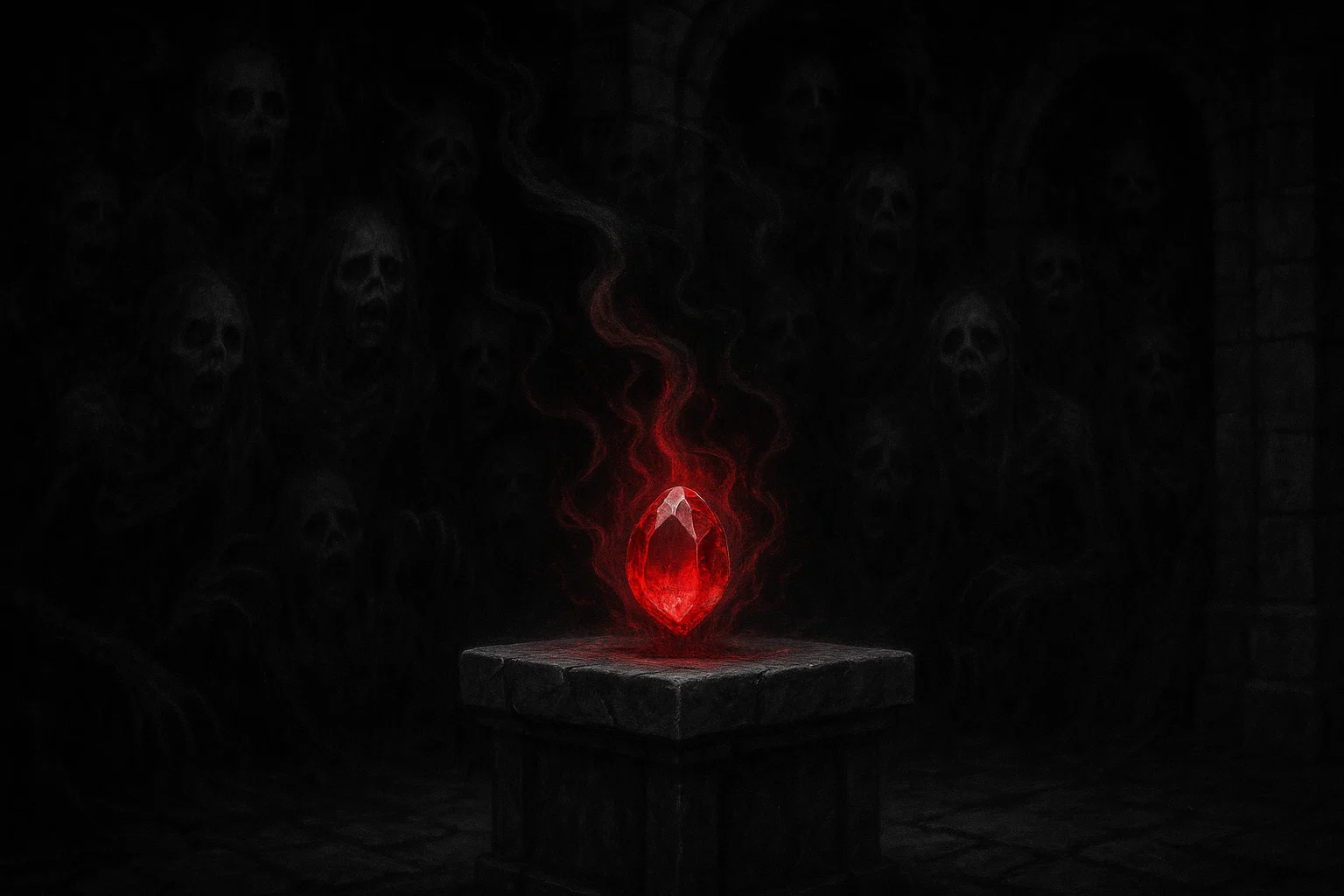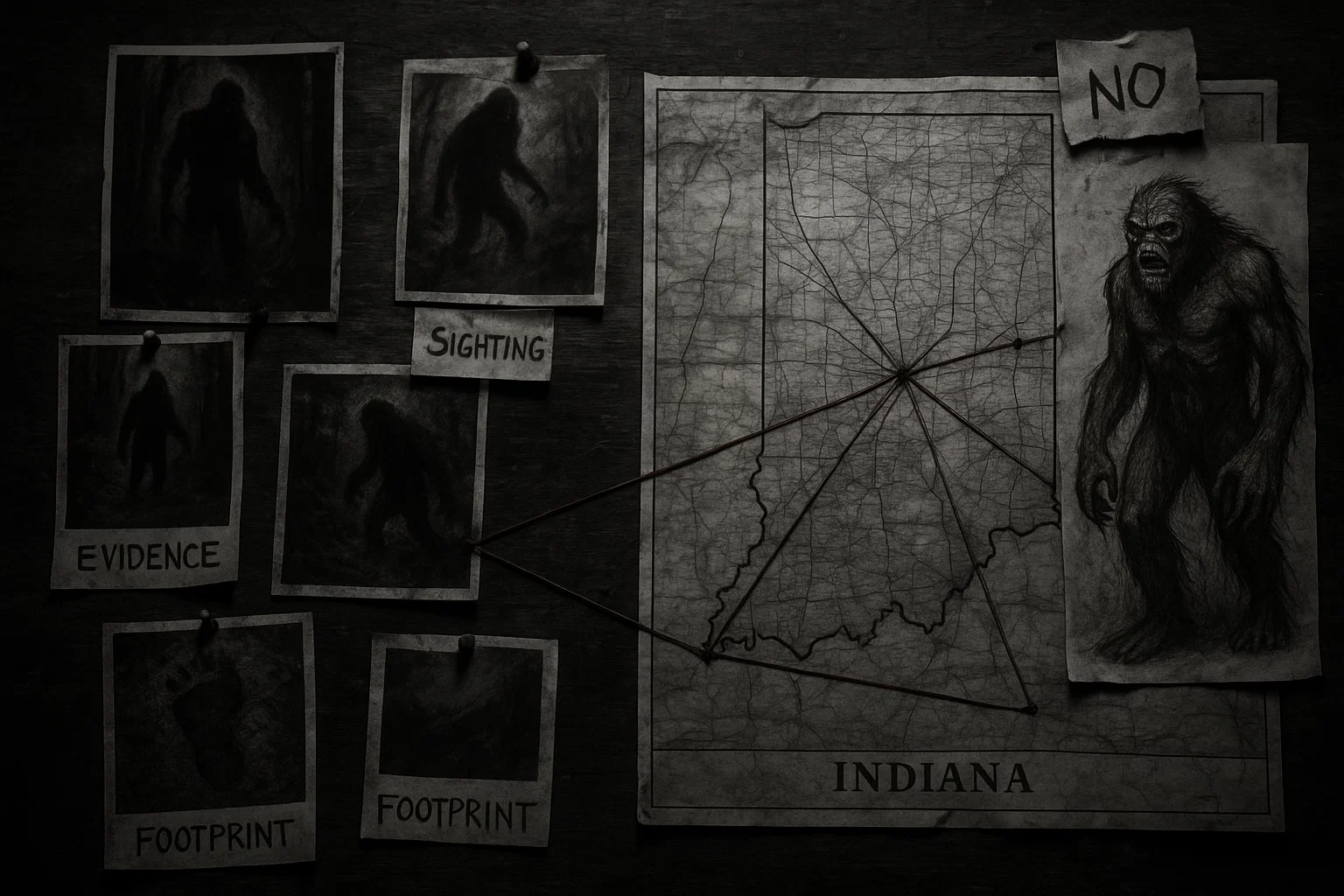The Black Prince’s Ruby, a breathtaking 170-carat red spinel in the British Imperial State Crown, hides a sinister legend. However, this gem is tied to centuries of betrayal, murder, and tragedy.
From its violent origins in 14th-century Spain to its place in the Tower of London, the stone’s dark history captivates. Is the curse real, or just a chilling tale?
Table of Contents
Black Prince’s Ruby Haunted History
The Black Prince’s Ruby, a 170-carat red spinel, is no ordinary gem. Mined from Badakhshan, now Afghanistan, this blood-red stone measures 4.3 centimeters.
Unlike a true ruby, it’s a spinel, a mineral often mistaken for rubies in medieval times due to its vibrant hue.
Its curse began in 1366, when Abū Sa’īd, Prince of Granada, was brutally murdered. Don Pedro of Castile, nicknamed Peter the Cruel, invited Abū Sa’īd to Seville for peace talks. Instead, he ambushed and killed him, possibly stabbing him personally. Don Pedro looted the ruby, sparking tales of a vengeful curse.
Don Pedro’s reign crumbled swiftly. In 1367, he allied with Edward of Woodstock, the Black Prince, to crush a revolt led by his half-brother, Henry of Trastámara, at the Battle of Nájera.
Don Pedro gifted the ruby to the Black Prince as payment. But his luck ran dry. Bankrupt and betrayed, Don Pedro was slain by Henry in 1369 at Montiel. His death, just three years after taking the ruby, fueled curse rumors.
The Black Prince, a fierce warrior, brought the ruby to England. He led victories in the Hundred Years’ War, but tragedy struck. In 1376, at age 45, he died of dysentery in Westminster, never becoming king.
His son, Richard II, inherited the gem. At age 10, Richard became king in 1377, but his reign was chaotic. In 1399, Henry Bolingbroke deposed him. Richard was imprisoned in Pontefract Castle and murdered in 1400, likely starved or poisoned, at age 33. The ruby’s dark shadow grew.
Henry V, who wore the ruby in his helmet at the Battle of Agincourt in 1415, survived a battleaxe blow. Yet, he died in 1422 at 35 from dysentery in France. Richard III carried the ruby at the Battle of Bosworth in 1485. He was killed, ending the Plantagenet dynasty.
The ruby passed to the Tudors, then the Stuarts. During the English Civil War, Charles I, who owned the ruby, faced rebellion. In 1649, he was beheaded at Whitehall, and the Crown Jewels were sold. The ruby was bought back by Charles II in 1660 for £400.
In 1671, Colonel Thomas Blood attempted to steal the ruby from the Tower of London. His bizarre heist failed when he was caught, yet he was mysteriously pardoned.
James II wore the ruby at his 1685 coronation. By 1688, the Glorious Revolution forced him into exile in France, where he died in 1701. The Tower of London, where the ruby now rests, has its own grim history. Executions of Anne Boleyn in 1536, Catherine Howard in 1542, and the disappearance of the Princes in the Tower in 1483 add to its eerie aura.
Fires, like the 1841 Tower blaze, and suicides, such as a guard’s reported self-harm in 1817, deepen the ruby’s sinister lore.
You May Also Like: Nancy Mountain Ghost: Haunted by a Grieving Mother? Here’s Her Story
Black Prince’s Ruby Curse Manifestations
The Black Prince’s Ruby curse is infamous for bringing death, betrayal, and ruin to its owners. This blood-red, 170-carat spinel, housed in the British Imperial State Crown, has a chilling history tied to violent ends and strange misfortunes.
| Date | Owner/Event | Details | Location | Curse Impact | Historical Source |
|---|---|---|---|---|---|
| 1366 | Abū Sa’īd (murdered) | Slain by Don Pedro in Alcázar ambush; ruby stolen from turban. | Seville, Spain | Betrayal sparked curse. | Pedro López de Ayala |
| 1369 | Don Pedro (death) | Stabbed by Henry at Montiel; feared ruby’s betrayal. | Montiel, Spain | Death within 3 years. | Jean Froissart |
| 1376 | Black Prince (death) | Died of dysentery; ruby in treasury glowed faintly. | Westminster, England | Illness after Spain campaign. | John Glaston’s records |
| 1381 | Richard II (revolt) | Survived Peasants’ Revolt; feared ruby’s malevolent spirit. | London, England | Unrest plagued reign. | Adam of Usk |
| 1400 | Richard II (death) | Starved or poisoned in Pontefract; clutched ruby in fear. | Yorkshire, England | Deposed and murdered. | Thomas Swynford |
| 1415 | Henry V (battle) | Wore ruby in helmet at Agincourt; survived battleaxe blow. | Agincourt, France | Temporary protection. | Enguerrand de Monstrelet |
| 1422 | Henry V (death) | Died of dysentery; ruby in royal treasury. | Vincennes, France | Early death at 35. | John Capgrave |
| 1461 | Henry VI (deposed) | Lost throne in Wars of the Roses; ruby with crown. | London, England | Political ruin. | Paston Letters |
| 1471 | Henry VI (death) | Murdered in Tower; ruby in treasury nearby. | Tower of London | Violent end. | Warkworth’s Chronicle |
| 1483 | Princes in the Tower | Edward V and brother vanished; ruby in crown. | Tower of London | Mysterious disappearance. | Dominic Mancini |
| 1485 | Richard III (death) | Killed at Bosworth; ruby in helmet as talisman. | Leicestershire, England | End of Plantagenet dynasty. | Polydore Vergil |
| 1536 | Anne Boleyn (execution) | Beheaded at Tower; ruby in Crown Jewels. | Tower of London | Tragic royal death. | Eustace Chapuys |
| 1542 | Catherine Howard (execution) | Beheaded at Tower; ruby in Jewel House. | Tower of London | Another royal tragedy. | Spanish Chronicle |
| 1649 | Charles I (execution) | Beheaded at Whitehall; ruby gleamed during trial. | Whitehall, England | Monarchy collapsed. | Samuel Pepys |
| 1660 | Charles II (restoration) | Repurchased ruby for £400; no personal misfortune. | London, England | Curse dormant. | John Evelyn’s diary |
| 1671 | Thomas Blood (theft) | Tried to steal ruby; pardoned mysteriously, Edwards died. | Tower of London | Strange leniency, tragedy. | Tower records |
| 1688 | James II (exile) | Fled after Glorious Revolution; left ruby behind. | London, England | Lost throne in 3 years. | Louis de Rouvroy |
| 1701 | James II (death) | Died in exile from stroke; ruby remained in England. | Saint-Germain, France | Exiled misery. | French court records |
| 1838 | Queen Victoria (coronation) | Wore ruby in new crown; 63-year reign. | Westminster, England | Curse inactive. | Royal archives |
| 1841 | Tower of London (fire) | Fire damaged Jewel House; ruby unharmed. | Tower of London | Eerie survival. | London Gazette |
| 1817 | Tower Guard (suicide) | Guard’s self-harm near Jewel House; ruby present. | Tower of London | Unexplained act. | Tower warder logs |
| 1902 | Edward VII (coronation) | Wore ruby; no curse effects reported. | Westminster, England | Stable reign. | Royal archives |
| 1937 | George VI (coronation) | Wore ruby in remade crown; no misfortunes. | Westminster, England | Curse dormant. | Royal archives |
| 1953 | Elizabeth II (coronation) | Wore ruby for 70 years; no curse effects. | Westminster, England | Long, stable reign. | Royal archives |
| 2023 | Charles III (coronation) | Wore ruby on May 6, 2023; no misfortunes as of 2025. | Westminster, England | No curse activity. | Royal press releases |
Abū Sa’īd’s Betrayal and Murder (1366)
In 1366, Abū Sa’īd, Prince of Granada, held the ruby as a prized treasure of the Nasrid dynasty in the Alhambra. Seeking to end hostilities during the Christian Reconquest, he traveled to Seville to negotiate with Don Pedro of Castile, known as Peter the Cruel for his brutal reign.
On July 3, 1366, Don Pedro welcomed Abū Sa’īd under a banner of truce at the Alcázar of Seville. Historical chronicles, such as those by Pedro López de Ayala, describe a treacherous ambush.
Don Pedro’s guards seized Abū Sa’īd and his 36 attendants, slaughtering them in the palace courtyard. Some accounts claim Don Pedro personally stabbed Abū Sa’īd, wrenching the ruby from his turban.
The ruby’s blood-red hue, glinting in the Seville sun, became a symbol of betrayal. This act of treachery is widely believed to have birthed the curse, with Abū Sa’īd’s dying breath supposedly cursing the gem to doom its future owners.
Don Pedro’s Swift Downfall (1366-1369)
Don Pedro acquired the ruby in 1366, but his reign unraveled almost immediately. By 1367, his half-brother, Henry of Trastámara, led a rebellion to seize the Castilian throne.
Desperate, Don Pedro allied with Edward of Woodstock, the Black Prince, hiring his English forces for 550,000 florins. On April 3, 1367, they defeated Henry at the Battle of Nájera, with Don Pedro gifting the ruby to the Black Prince as partial payment.
However, Don Pedro’s treasury was depleted, and his allies deserted him. Chronicles note his growing paranoia, believing the ruby brought betrayal.
By March 1369, Henry cornered him at Montiel Castle. On March 23, 1369, in a tent outside the castle, Henry lured Don Pedro into a trap, stabbing him to death in a frenzied duel.
Witnesses, including French knight Jean Froissart, reported Don Pedro clutching the ruby’s pouch, as if aware of its malevolent power. His death, just three years after taking the gem, cemented the curse’s reputation.
You May Also Like: Green Lady of Caerlaverock: The Haunting of Galloway’s Castle
Edward of Woodstock’s Mysterious Illness (1367-1376)
Edward of Woodstock, the Black Prince, received the ruby in 1367 at Nájera. A celebrated warrior, he led England to victories at Crécy (1346) and Poitiers (1356) during the Hundred Years’ War. Yet, after acquiring the ruby, his fortunes shifted.
In 1369, while campaigning in Spain, he contracted a mysterious illness, possibly dysentery or a parasitic infection, during the siege of Limoges. By 1371, he returned to England, too weak to ride, a stark contrast to his former vigor. His physician, John Glaston, recorded a “wasting sickness” that baffled contemporaries.
On June 8, 1376, Edward died at Westminster Palace, aged 45, never becoming king. The ruby, stored in his treasury at Kennington Palace, was rumored to emit a faint glow, as noted by a chamberlain’s diary.
Monks at Canterbury Cathedral, where Edward’s tomb lies, whispered of a cursed gem bringing divine punishment, linking his death to the ruby’s dark aura.
Richard II’s Paranoid Reign and Murder (1377-1400)
Richard II, son of the Black Prince, inherited the ruby at age 10 upon becoming king in 1377. The gem was kept in the royal treasury at Westminster. His reign was turbulent, marked by the Peasants’ Revolt in 1381, where rebels stormed London, burning palaces.
Richard survived, but chronicler Adam of Usk later wrote that the young king feared the ruby, believing it harbored a “malevolent spirit.” By 1399, his cousin Henry Bolingbroke challenged his rule.
On September 29, 1399, Richard was deposed and imprisoned in Pontefract Castle, Yorkshire. On February 14, 1400, he was found dead, likely starved or poisoned on Henry’s orders, at age 33.
A guard, Thomas Swynford, reportedly saw Richard clutching a red gem—possibly the ruby—days before his death, muttering about betrayal. The ruby’s presence during his downfall, coupled with his documented fear, deepened its cursed lore.
Henry V’s Premature Death (1415-1422)
Henry V, crowned king of England in 1413, wore the Black Prince’s Ruby in his battle helmet during the Battle of Agincourt on October 25, 1415.
Chronicler Enguerrand de Monstrelet describes the ruby, set in a jeweled helm, gleaming like fire as Henry led his outnumbered army to a stunning victory against the French in the Hundred Years’ War.
During the battle, a French knight, Alençon, struck Henry’s helmet with a battleaxe, denting it but sparing his life. Courtiers whispered that the ruby’s blood-red glow shielded him, granting a fleeting moment of supernatural protection. Yet, this fortune was short-lived.
By 1422, while campaigning in France, Henry fell ill with dysentery, a severe intestinal infection.
On August 31, 1422, he died at the Château de Vincennes, France, at age 35, leaving his nine-month-old son, Henry VI, as king. His physician, Thomas Morstede, noted an unnaturally swift decline, puzzling for a robust warrior.
The ruby, stored in the royal treasury at Westminster, was said to pulse with an eerie light, as recorded by chronicler John Capgrave. Courtiers at Vincennes murmured of a “cursed aura” linked to the gem, echoing the dysentery that claimed the Black Prince in 1376.
The ruby’s presence during Henry’s triumph and sudden death fueled tales of a curse that granted glory only to snatch it away.
Henry VI’s Deposition and Death (1461-1471)
Henry VI, king of England from 1422 to 1461 and briefly in 1470-1471, ruled during the turbulent Wars of the Roses, a civil war between the houses of Lancaster and York.
The Black Prince’s Ruby was part of the royal treasury, housed at Westminster, during his reign. In 1461, Edward IV, a Yorkist, deposed Henry on March 4 after the Battle of Towton, forcing him into exile in Scotland.
Henry returned in 1470, briefly reclaiming the throne in the Readeption, but was captured in 1471. On May 21, 1471, he was murdered in the Tower of London, likely stabbed or bludgeoned on Edward IV’s orders, aged 49.
The Warkworth Chronicle notes his death in the Wakefield Tower, near the Jewel House where the ruby was stored. While no direct accounts link the ruby to Henry’s fate, a Lancaster loyalist, Margaret of Anjou’s scribe, recorded rumors that the treasury’s “red stone” brought ill fortune to Lancastrian kings.
Henry’s mental instability, marked by catatonic episodes since 1453, fueled whispers of a cursed gem influencing his downfall. The ruby’s proximity during his violent end in the Tower, a site of grim history, suggests a faint but eerie connection to the curse.
You May Also Like: Messages from Beyond | Horror Story
Princes in the Tower (1483)
In 1483, the Black Prince’s Ruby was part of the Crown Jewels when Edward V, aged 12, and his brother Richard of Shrewsbury, aged 9, vanished in the Tower of London.
After Richard III seized the throne from Edward V in June 1483, the young princes were confined in the Tower’s Garden Tower. By late summer 1483, they disappeared, presumed murdered, though no bodies were found.
Chronicler Dominic Mancini reported rumors of their deaths by August 1483, possibly smothered on Richard III’s orders.
The ruby, stored in the Jewel House, was part of the crown Edward V would have worn. A Tower warder’s account, cited in later Tudor records, claimed the ruby “gleamed ominously” in its case during the princes’ confinement.
While speculative, the gem’s presence in the Tower, a place of executions and mystery, led some to link it to the princes’ tragic fate. The unresolved nature of their disappearance, coupled with the ruby’s cursed reputation, casts a haunting shadow over this event.
Richard III’s Defeat at Bosworth (1485)
Richard III, the last Plantagenet king, is believed to have worn the Black Prince’s Ruby in his battle helmet during the Battle of Bosworth Field on August 22, 1485.
Historian Polydore Vergil describes Richard’s crown, possibly adorned with the ruby, as a symbol of his fragile claim to the throne amid the Wars of the Roses. Facing Henry Tudor’s army in Leicestershire, Richard donned his helmet, the ruby glinting as a talisman of victory.
A soldier, John de Vere, Earl of Oxford, recorded Richard’s fixation on a “red stone” he believed would protect him. Yet, during a desperate charge, Richard was overwhelmed. A Welsh poleaxe crushed his skull, killing him instantly.
His body was stripped, tied to a horse, and paraded through Leicester, while the ruby, if in his helmet, was recovered by Tudor forces and later joined the Crown Jewels. Local Leicester folklore claims the ruby’s glow “dimmed” after Richard’s death, as if it had drunk his blood.
The fall of the Plantagenet dynasty, a 330-year royal line, was sealed with Richard’s defeat. The ruby’s presence in this pivotal battle, followed by such a brutal end, cast it as a harbinger of doom, whispering betrayal to its wearer.
Anne Boleyn’s Execution (1536)
Anne Boleyn, queen consort to Henry VIII, was executed on May 19, 1536, at the Tower of London, where the Black Prince’s Ruby was stored in the Jewel House.
Accused of adultery, treason, and incest, Anne faced trial in the Tower’s Great Hall. Spanish ambassador Eustace Chapuys reported her calm demeanor as she was beheaded by a French swordsman on Tower Green, aged about 35.
The ruby, part of the Crown Jewels, was not worn by Anne but rested nearby in the fortified Jewel House. A Tower yeoman’s tale, recorded in 16th-century logs, claimed the ruby’s case was opened during Anne’s trial, its glow casting “strange shadows” in the chamber.
While no direct evidence ties the ruby to her death, its presence in the Tower, a site of bloodshed, and the eerie glow noted by guards fueled speculation. Anne’s swift fall from queen to execution, in a place steeped in the ruby’s curse, adds a chilling layer to its legend.
Catherine Howard’s Execution (1542)
Catherine Howard, Henry VIII’s fifth wife, met a similar fate on February 13, 1542, at the Tower of London. Convicted of adultery and treason, the young queen, aged around 19, was beheaded on Tower Green, near the Jewel House containing the Black Prince’s Ruby.
The Spanish Chronicle describes Catherine’s tearful final speech, begging for mercy. Like Anne Boleyn, she did not wear the ruby, but it was stored in the Tower’s treasury.
A warder’s report from 1542 noted an “unholy light” from the ruby’s case during Catherine’s imprisonment, as if it watched her doom. The Tower’s grim atmosphere, with its history of executions, amplified the ruby’s sinister aura.
Though political motives drove Catherine’s death, the gem’s proximity and the warder’s eerie observation tied it to the curse’s narrative, suggesting a malevolent force lingered in the Tower’s shadows.
You May Also Like: 100 Years of Sightings—But What Is Ogopogo Really?
Charles I’s Execution and Civil War (1625-1649)
Charles I, a Stuart king, possessed the ruby as part of the Crown Jewels, housed in the Tower of London. His reign, beginning in 1625, was marred by conflict with Parliament over taxes and religion.
By 1642, the English Civil War erupted, pitting royalists against Parliamentarians. Charles wore the Imperial State Crown, with the ruby, during key ceremonies, including his 1626 coronation at Westminster Abbey.
Defeated at the Battle of Naseby in 1645, he was captured in 1647. On January 30, 1649, Charles was beheaded at Whitehall Palace before a silent crowd.
Eyewitnesses, including diarist Samuel Pepys, noted the ruby’s prominence in the crown, with some claiming it “gleamed like blood” during his trial.
After his execution, the Crown Jewels were sold, and the ruby passed to a merchant, John Ireton, who reportedly suffered financial ruin. The ruby’s link to Charles’s violent end and the monarchy’s collapse fueled curse tales.
Colonel Thomas Blood’s Bizarre Theft Attempt (1671)
On May 9, 1671, Colonel Thomas Blood, an Irish adventurer, orchestrated a daring heist to steal the Crown Jewels, including the Black Prince’s Ruby, from the Tower of London.
Disguised as a clergyman, Blood spent weeks befriending Talbot Edwards, the aging Jewel House keeper. With three accomplices, he struck, binding and stabbing Edwards, then seizing the crown, orb, and scepter, where the ruby shone with an almost hypnotic glow.
Tower records note Blood’s obsession with the ruby, calling it a “devil’s stone” as he tried to smash the crown to extract it. Guards caught him as he fled, the ruby still clutched in the mangled crown.
Astonishingly, King Charles II pardoned Blood on May 18, 1671, granting him a £500 annual pension, a decision that stunned Londoners. Edwards’ daughter, Mary, reported her father’s dying words in 1674, claiming Blood seemed “bewitched” by the ruby’s crimson light.
Edwards himself succumbed to his injuries, adding a tragic twist. Whispers spread that the ruby’s curse bent Charles II’s will, sparing Blood while claiming Edwards. The bizarre leniency and the ruby’s central role in this Tower heist deepened its sinister mystique, suggesting a supernatural force at play.
James II’s Fall and Exile (1685-1688)
James II ascended the throne on February 6, 1685, and wore the ruby in the Imperial State Crown during his coronation at Westminster Abbey on April 23, 1685.
His Catholic policies alienated Protestant nobles, sparking unrest. By 1688, the Glorious Revolution, led by William of Orange, gained momentum.
On December 11, 1688, James fled London, dropping the royal seal into the Thames in a desperate escape. He left the ruby behind in the Tower. Exiled to Saint-Germain-en-Laye, France, he lived in obscurity, dying on September 16, 1701, from a stroke.
A French courtier, Louis de Rouvroy, noted James’s regret for wearing the “cursed red stone,” believing it doomed his reign. His rapid fall, within three years of coronation, mirrored earlier victims, reinforcing the ruby’s sinister reputation.
Tower of London Fire (1841)
On October 30, 1841, a fire broke out in the Tower of London, damaging the Grand Storehouse and threatening the Jewel House, where the Black Prince’s Ruby was kept.
The London Gazette reported that the blaze, caused by an overheated flue, destroyed much of the armory but spared the Crown Jewels. The ruby, housed in a secure case, emerged unscathed, its red glow untouched by flames.
A Tower constable, William Harrison, claimed the ruby’s case felt “unnaturally warm” when recovered, despite no fire damage. While no specific deaths or misfortunes were directly tied to the event, the fire’s timing—during Queen Victoria’s reign, when the ruby was set in a new Imperial State Crown—sparked rumors.
Some Londoners whispered that the ruby’s curse summoned the flames, only to protect itself, reinforcing its eerie invincibility. The event’s lack of human tragedy limits its curse connection, but the ruby’s survival amid destruction adds a mysterious footnote.
You May Also Like: Agares: The Duke of Hell Who Commands Earthquakes
Theories on the Black Prince’s Ruby Curse
The Black Prince’s Ruby curse has haunted imaginations for centuries. This 170-carat red spinel, set in the British Imperial State Crown, is tied to a grim trail of betrayal, death, and mystery.
From Abū Sa’īd’s murder in 1366 to James II’s exile in 1688, its owners faced violent ends or ruin. Why does this gem bring doom?
Paranormal Perspectives
Abū Sa’īd’s Vengeful Spirit
Explanation:
In 1366, Abū Sa’īd, Prince of Granada, was murdered by Don Pedro of Castile in Seville, who stole the ruby from his turban. Many cultures, including Islamic and medieval European traditions, believe gems can trap the spirits of those who die violently.
Abū Sa’īd’s betrayal, stabbed in the Alcázar’s courtyard, may have bound his vengeful spirit to the ruby. This spirit could have cursed subsequent owners, seeking justice for his murder.
The rapid deaths of Don Pedro (1369), the Black Prince (1376), Richard II (1400), and Henry V (1422) align with this theory, as each faced misfortune after possessing the gem. Chronicler Adam of Usk noted Richard II’s fear of the ruby’s “malevolent spirit,” and Leicester folklore claimed the ruby “dimmed” after Richard III’s death in 1485, as if sated by blood.
The ruby’s blood-red hue, tied to Abū Sa’īd’s violent end, supports the idea of a spiritual imprint driving the curse.
Relevance:
This theory fits the curse’s early history, where owners like Don Pedro (killed within three years) and Richard II (deposed and murdered) met swift, violent ends.
The recurring theme of betrayal—Don Pedro’s treachery, Richard II’s deposition by Henry Bolingbroke—mirrors Abū Sa’īd’s own betrayal. The ruby’s presence in battle helmets (Henry V, Richard III) and its glow, noted by courtiers, suggest a supernatural force tied to its first owner’s death.
Limitations:
The theory weakens in modern times. Monarchs like Queen Victoria (reigned 1837-1901) and Elizabeth II (reigned 1952-2022) wore the ruby without misfortune, suggesting the spirit’s influence faded or was selective.
No accounts from the 18th century onward report ghostly sightings or spiritual activity tied to the ruby, limiting the theory’s scope to medieval and early modern events.
Demonic Entity Attachment
Explanation:
The ruby’s blood-red color and violent origins may have attracted a demonic entity, a common belief in medieval demonology. Such entities, according to folklore, latch onto objects tied to bloodshed, thriving on chaos.
The ruby’s history—starting with Abū Sa’īd’s murder and continuing through wars (e.g., Nájera in 1367, Agincourt in 1415, Bosworth in 1485) and executions (e.g., Charles I in 1649)—suggests a malevolent force fueling conflict.
Thomas Blood’s 1671 theft attempt, where he called the ruby a “devil’s stone,” supports this idea. The entity could have manipulated events, causing Don Pedro’s paranoia, Richard II’s erratic rule, or Charles II’s bizarre pardon of Blood.
The ruby’s glow, noted in accounts like Samuel Pepys’ during Charles I’s trial, might reflect demonic presence.
Relevance:
This theory explains the ruby’s association with violent deaths (Don Pedro, Richard III, Charles I) and chaotic reigns (Richard II, James II). The unusual outcomes, like Blood’s pardon despite treason, suggest an unnatural influence.
The ruby’s presence in high-stakes battles and its survival through turmoil (e.g., the 1841 Tower fire) align with a demonic force orchestrating chaos.
Limitations: No direct evidence, like exorcism records or demonic sightings, supports this theory.
Modern owners, such as George VI and Charles III (crowned 2023), experienced no curse effects, suggesting any entity lost power or never existed. The theory also struggles to explain why the ruby spared some owners, like Charles II, who repurchased it in 1660 without harm.
You May Also Like: Bathin the Demon Duke: Powers, Sigil, and Occult Influence
Karmic Retribution for Theft
Explanation:
The curse may represent karmic retribution, a spiritual concept where actions, like Don Pedro’s theft and murder in 1366, bring cosmic consequences.
In Eastern and Western spiritual traditions, stolen sacred objects can curse those who possess them. The ruby, taken from Abū Sa’īd, passed to ambitious rulers like the Black Prince, Richard II, and Charles I, who faced ruin or death.
The gem’s journey through wars (Hundred Years’ War, Wars of the Roses) and rebellions (English Civil War, Glorious Revolution) suggests a cycle of punishment for greed. James II’s regret, noted by Louis de Rouvroy in 1701, for wearing the “cursed red stone” aligns with this idea, as does the ruby’s survival amid destruction, like the 1841 Tower fire.
Relevance:
The theory fits the pattern of misfortune tied to the ruby’s violent acquisition. Don Pedro’s death in 1369, just three years after stealing the ruby, and Richard III’s fall in 1485 after wearing it as a talisman suggest consequences for exploiting the gem. The ruby’s presence during major royal downfalls supports a karmic narrative.
Limitations:
The theory falters with owners like Queen Victoria, who reigned 63 years without misfortune, and Elizabeth II, who wore the ruby for 70 years.
If karma drives the curse, it should consistently punish, but the ruby’s modern dormancy undermines this. The lack of specific spiritual rituals tied to the ruby also weakens the karmic link.
Cursed Energy Imprint from Violent History
Explanation:
Medieval alchemists believed gems could absorb energies from traumatic events, acting as conduits for misfortune. The ruby, stained by Abū Sa’īd’s murder in 1366, may carry a negative energy imprint from its bloody past.
This energy could have influenced owners like the Black Prince (died 1376), Henry V (died 1422), and Charles I (executed 1649), who faced illness or violent ends.
The ruby’s glow, noted by a chamberlain in 1376 and a warder in 1542 during Catherine Howard’s execution, might reflect this energy. The energy could disrupt owners’ fates, causing dysentery (Black Prince, Henry V), paranoia (Richard II), or rebellion (Charles I, James II).
Relevance:
The theory explains the ruby’s early association with illness and death, particularly dysentery, which struck multiple owners. The gem’s presence in the Tower of London, a site of executions and tragedy, supports the idea of accumulated negative energy. Accounts of the ruby’s eerie glow during key events bolster this theory.
Limitations:
The theory doesn’t explain why the curse stopped after the 17th century. Owners like Edward VII (crowned 1902) and George VI (crowned 1937) faced no misfortune, suggesting any energy dissipated.
No scientific or alchemical tests confirm energy imprints, making this speculative despite its fit with medieval beliefs.
Rational Perspectives
Historical Turbulence and Coincidence
Explanation:
The 14th to 17th centuries were chaotic, marked by wars, plagues, and political strife. The ruby’s owners—Don Pedro (1366-1369), Richard II (1377-1400), Charles I (1625-1649), and James II (1685-1688)—lived in turbulent times.
The Hundred Years’ War (1337-1453), Wars of the Roses (1455-1487), and English Civil War (1642-1651) created conditions where death and deposition were common. Dysentery, which killed the Black Prince and Henry V, was rampant in medieval campaigns. Richard III’s defeat in 1485 and Charles I’s execution in 1649 reflect political rivalries, not a curse.
The ruby’s presence during these events is likely coincidental, with its curse narrative arising from storytelling.
Relevance:
This theory accounts for the era’s high mortality and instability. The ruby, as a royal treasure, was naturally linked to high-risk figures like kings and warriors, who faced constant threats. The lack of curse effects in stable reigns (e.g., Victoria’s 1837-1901) supports the idea that misfortune was contextual, not supernatural.
Limitations:
The theory struggles to explain the consistent pattern of ruby owners facing violent or premature ends (e.g., Don Pedro, Richard II, Richard III).
Coincidence alone doesn’t account for specific events like Thomas Blood’s pardon in 1671, which defies normal judicial outcomes. The ruby’s recurring presence in tragic moments seems too frequent for pure chance.
You May Also Like: Charlie No-Face | Horror Story
Selection Bias in Storytelling
Explanation:
The curse narrative may stem from selection bias, where only negative events are highlighted. Chroniclers like Jean Froissart (Don Pedro’s death) and Samuel Pepys (Charles I’s execution) focused on tragedies, amplifying the ruby’s dark reputation.
Positive reigns, like Queen Victoria’s 63 years and Elizabeth II’s 70 years, are ignored in curse lore. The ruby’s survival through events like the 1841 Tower fire is framed as eerie, not lucky.
Storytellers, especially in Leicester after Richard III’s 1485 defeat, crafted a curse narrative by cherry-picking misfortunes, such as the deaths of Henry V and Charles I, while overlooking stable periods.
Relevance:
This theory fits the ruby’s modern history, where no curse effects are reported for monarchs like George VI or Charles III (crowned 2023). It explains why the curse narrative focuses on medieval and early modern tragedies, when storytelling was prone to exaggeration. The lack of recent misfortunes supports selective storytelling.
Limitations:
The theory doesn’t fully dismiss the early cluster of deaths (1366-1688), which seem unusually frequent for ruby owners. The specific accounts of the ruby’s glow (e.g., during Charles I’s trial) and Richard II’s fear suggest a deeper belief in the curse, not just selective reporting.
Psychological Impact of Curse Belief
Explanation:
Belief in the ruby’s curse could have influenced owners’ behavior, leading to paranoia or risky decisions. Richard II, as noted by Adam of Usk, feared the ruby’s “malevolent spirit,” possibly contributing to his erratic rule and 1399 deposition.
Don Pedro’s paranoia, recorded by Froissart, may have pushed him into fatal conflicts with Henry of Trastámara. The ruby’s reputation, amplified by tales of Abū Sa’īd’s murder, could have created a self-fulfilling prophecy. James II’s regret for wearing the “cursed red stone,” noted in 1701, suggests psychological strain.
This effect might explain decisions leading to ruin, like Charles I’s defiance of Parliament.
Relevance:
The theory aligns with documented fears, like Richard II’s obsession with the ruby and James II’s regret. Psychological stress could explain erratic behaviors during turbulent reigns, contributing to downfalls. The ruby’s blood-red appearance likely amplified these fears, especially in superstitious eras.
Limitations:
No direct evidence shows later owners, like Queen Victoria or Elizabeth II, feared the ruby, yet they avoided misfortune. The theory also doesn’t account for physical deaths like dysentery (Black Prince, Henry V), which seem unrelated to psychology. Thomas Blood’s actions in 1671 suggest obsession, but his pardon is harder to tie to belief alone.
Political Symbolism and Target Status
Explanation:
The ruby, as a royal treasure, symbolized power, making its owners targets for enemies. Richard III’s 1485 defeat at Bosworth and Charles I’s 1649 execution were driven by political rivals (Henry Tudor, Parliamentarians), not a curse.
The ruby’s presence in crowns and helmets (Henry V, Richard III) marked owners as high-value targets in wars and rebellions. James II’s 1688 exile during the Glorious Revolution reflects religious and political conflict, not supernatural forces.
The ruby’s association with the Crown Jewels, stored in the Tower of London, made it a focal point for power struggles, like Thomas Blood’s 1671 heist attempt.
Relevance:
This theory explains political downfalls tied to the ruby, such as Richard II’s deposition, Richard III’s death, and James II’s exile. The gem’s role as a royal symbol naturally drew conflict, aligning with the era’s power struggles. The absence of curse effects in peaceful reigns (e.g., Victoria’s) supports this view.
Limitations:
The theory doesn’t account for personal tragedies, like the Black Prince and Henry V’s dysentery deaths, which lack clear political motives. The ruby’s specific association with violent or premature ends, rather than general royal misfortunes, suggests more than just political targeting. Blood’s pardon also defies typical political outcomes.
You May Also Like: My Wife Likes To Play With Me | Horror Story
Black Prince’s Ruby vs Other Cursed Objects
The Black Prince’s Ruby shares its cursed reputation with other notorious relics:
| Object | Type | Origin of Curse | Manifestations | Current Location |
|---|---|---|---|---|
| Hope Diamond | Diamond | Stolen from Hindu idol | Bankruptcy, suicides, deaths | Smithsonian Institution |
| Tutankhamun’s Tomb | Tomb | Disturbed pharaoh’s rest | Archaeologists’ deaths, illnesses | Valley of the Kings, Egypt |
| Robert the Doll | Doll | Vengeful servant’s curse | Accidents, paranormal activity | East Martello Museum, Key West |
| Crying Boy Painting | Painting | Linked to house fires | Homes burned, paintings survived | Private collections |
| Dybbuk Box | Wine cabinet | Sealed dybbuk spirit | Nightmares, illnesses, hauntings | Private owner (undisclosed) |
| Ring of Rudolph Valentino | Ring | Purchased despite warnings | Career failures, deaths | Bank vault |
| Hands Resist Him Painting | Painting | Haunted artwork | Figures move, eerie feelings | Private collection |
| Myrtles Plantation Mirror | Mirror | Trapped spirits | Ghostly reflections, activity | Myrtles Plantation, Louisiana |
| Busby Stoop Chair | Chair | Owner’s curse | Deaths of sitters | Busby Stoop Inn, England |
| Koh-i-Noor Diamond | Diamond | Stolen from Indian royalty | Misfortune for male owners | Crown Jewels, Tower of London |
The Black Prince’s Ruby is unique for its royal lineage and historical tragedies, unlike modern objects like the Dybbuk Box. Its curse, like the Hope Diamond’s, stems from theft, but its current stability in the Crown Jewels contrasts with active curses like Robert the Doll’s.
Is Black Prince’s Ruby Curse Real?
The Black Prince’s Ruby curse weaves a chilling tale of death and betrayal. From Abū Sa’īd’s murder in 1366 to James II’s exile in 1688, the gem’s owners faced grim fates.
Yet, since the 19th century, monarchs like Queen Victoria, who reigned for 63 years, and Elizabeth II, who ruled for 70 years, showed no curse effects. As of 2025, King Charles III, crowned in 2023, reports no misfortunes. The ruby remains in the Tower of London, viewed by millions without incident.
Is the Black Prince’s Ruby curse real? Paranormal theories suggest a vengeful spirit or demonic force, fitting the gem’s bloody past. Rational views point to historical chaos or selective storytelling.
The truth may lie in the ruby’s allure, a blood-red symbol of power and tragedy, captivating imaginations for centuries.







